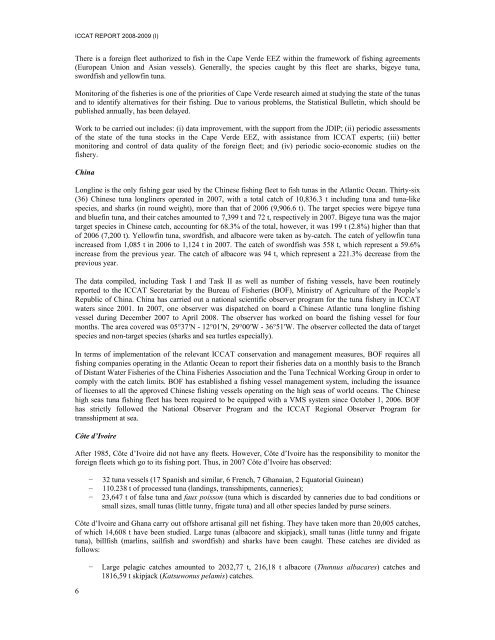REPORT OF THE STANDING COMMITTEE ON RESEARCH ... - Iccat
REPORT OF THE STANDING COMMITTEE ON RESEARCH ... - Iccat
REPORT OF THE STANDING COMMITTEE ON RESEARCH ... - Iccat
Create successful ePaper yourself
Turn your PDF publications into a flip-book with our unique Google optimized e-Paper software.
ICCAT <strong>REPORT</strong> 2008-2009 (I)There is a foreign fleet authorized to fish in the Cape Verde EEZ within the framework of fishing agreements(European Union and Asian vessels). Generally, the species caught by this fleet are sharks, bigeye tuna,swordfish and yellowfin tuna.Monitoring of the fisheries is one of the priorities of Cape Verde research aimed at studying the state of the tunasand to identify alternatives for their fishing. Due to various problems, the Statistical Bulletin, which should bepublished annually, has been delayed.Work to be carried out includes: (i) data improvement, with the support from the JDIP; (ii) periodic assessmentsof the state of the tuna stocks in the Cape Verde EEZ, with assistance from ICCAT experts; (iii) bettermonitoring and control of data quality of the foreign fleet; and (iv) periodic socio-economic studies on thefishery.ChinaLongline is the only fishing gear used by the Chinese fishing fleet to fish tunas in the Atlantic Ocean. Thirty-six(36) Chinese tuna longliners operated in 2007, with a total catch of 10,836.3 t including tuna and tuna-likespecies, and sharks (in round weight), more than that of 2006 (9,906.6 t). The target species were bigeye tunaand bluefin tuna, and their catches amounted to 7,399 t and 72 t, respectively in 2007. Bigeye tuna was the majortarget species in Chinese catch, accounting for 68.3% of the total, however, it was 199 t (2.8%) higher than thatof 2006 (7,200 t). Yellowfin tuna, swordfish, and albacore were taken as by-catch. The catch of yellowfin tunaincreased from 1,085 t in 2006 to 1,124 t in 2007. The catch of swordfish was 558 t, which represent a 59.6%increase from the previous year. The catch of albacore was 94 t, which represent a 221.3% decrease from theprevious year.The data compiled, including Task I and Task II as well as number of fishing vessels, have been routinelyreported to the ICCAT Secretariat by the Bureau of Fisheries (B<strong>OF</strong>), Ministry of Agriculture of the People’sRepublic of China. China has carried out a national scientific observer program for the tuna fishery in ICCATwaters since 2001. In 2007, one observer was dispatched on board a Chinese Atlantic tuna longline fishingvessel during December 2007 to April 2008. The observer has worked on board the fishing vessel for fourmonths. The area covered was 05°37′N - 12°01′N, 29°00′W - 36°51′W. The observer collected the data of targetspecies and non-target species (sharks and sea turtles especially).In terms of implementation of the relevant ICCAT conservation and management measures, B<strong>OF</strong> requires allfishing companies operating in the Atlantic Ocean to report their fisheries data on a monthly basis to the Branchof Distant Water Fisheries of the China Fisheries Association and the Tuna Technical Working Group in order tocomply with the catch limits. B<strong>OF</strong> has established a fishing vessel management system, including the issuanceof licenses to all the approved Chinese fishing vessels operating on the high seas of world oceans. The Chinesehigh seas tuna fishing fleet has been required to be equipped with a VMS system since October 1, 2006. B<strong>OF</strong>has strictly followed the National Observer Program and the ICCAT Regional Observer Program fortransshipment at sea.Côte d’IvoireAfter 1985, Côte d’Ivoire did not have any fleets. However, Côte d’Ivoire has the responsibility to monitor theforeign fleets which go to its fishing port. Thus, in 2007 Côte d’Ivoire has observed:−−−32 tuna vessels (17 Spanish and similar, 6 French, 7 Ghanaian, 2 Equatorial Guinean)110.238 t of processed tuna (landings, transshipments, canneries);23,647 t of false tuna and faux poisson (tuna which is discarded by canneries due to bad conditions orsmall sizes, small tunas (little tunny, frigate tuna) and all other species landed by purse seiners.Côte d’Ivoire and Ghana carry out offshore artisanal gill net fishing. They have taken more than 20,005 catches,of which 14,608 t have been studied. Large tunas (albacore and skipjack), small tunas (little tunny and frigatetuna), billfish (marlins, sailfish and swordfish) and sharks have been caught. These catches are divided asfollows:6− Large pelagic catches amounted to 2032,77 t, 216,18 t albacore (Thunnus albacares) catches and1816,59 t skipjack (Katsuwonus pelamis) catches.
















